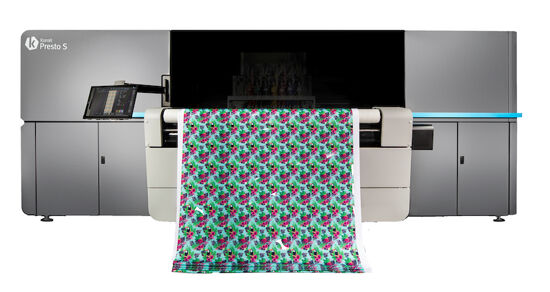The evolution of Textile Printing from Screen to Inkjet
Debbie McKeegan looks at the evolution of textile printing with Stead McAlpin, a 200 year old textile business based in Lancashire. The business now focused on hybrid printing with 40% of production focusing on digital textile printing and an empahisis on sustainability.
Stead McAlpin, a historic textile printing business formed in 1835 is based in Carlisle, Lancashire and has a rich, and enviable textile heritage. Their archive contains many historical patterns, which include a floral chintz pattern painted by Queen Victoria herself, and a damask print that graced the dining room of the doomed Titanic.
With a production legacy of almost 200 years, the company has always been at the forefront of innovation. And today the company operates a hybrid printing philosophy, bridging tradition with digital innovation. The journey to digital printing began with sampling and short run printing – Digital production now facilitates 40% of their expanding output.
From the inception of the company, Stead McAlpin has demonstrated a strong commitment to craftsmanship and quality, establishing itself as a hallmark supplier within the textile industry, whilst also cementing the company's reputation for excellence.
Stead McAlpin hold a renowned reputation for high quality screen printing which remains an important part of their production workflow for both rotary and flatbed output. However, to meet market demands and to achieve manufacturing efficiency for on-demand production - the business has also embraced all that digital ink-jet technologies now offer.
Recognizing the potential of digital production, Stead McAlpin looked to partner with a technology provider that held a deep technical understanding of the textile printing industry and its specifications and chose to work with Zimmer Austria. In partnership with Zimmer, Stead McAlpin meticulously trialled and compared the digital process to screen to ensure that high quality output was maintained. These trials were instrumental in understanding the capabilities and limitations of digital methods.
The Digital Leap – Full scale Digital Production
About four years ago, the company took a significant leap into full-scale digital production. This transition was not taken lightly; it was the result of extensive research, development, and a keen understanding of market demands. The move was fuelled by the introduction of the Zimmer Austria’s VAT ink system, which fulfilled all the company's requirements, particularly in terms of quality and fastness.
The VAT system proved to be a game-changer. It allowed for a seamless integration of digital printing into the production process, ensuring that the final products retained the rich, vibrant colours and durability that customers had come to expect from Stead McAlpin. The digital leap was a calculated risk that paid off handsomely, enabling the company to expand its capabilities and offer a wider range of products to its discerning clientele.
Today, digital textile printing constitutes around 40% of Stead McAlpin's production, a testament to the success of this bold move and their partnership with Zimmer Austria.
The transition to digital also opened up many new possibilities for creative expression and customisation. Unlike traditional methods, digital printing allows for an unprecedented level of flexibility in design. Complex patterns, gradients, and heritage designs can now be reproduced with stunning accuracy, offering designers a new palette for innovation. This capability has attracted a new generation of designers and clients who seek unique, on-demand, bespoke textiles that stand out in a crowded marketplace.
Digital VAT ink Printing - A Game Changer
The digital VAT ink system introduced by Zimmer Austria replicates the high print quality traditionally associated with screen printing.
The system's advanced technology ensures that the printed colours are not only vibrant but also long-lasting. This durability is critical for applications in drapery and upholstery, where the textiles must withstand daily wear and tear. The deep penetration of colour into the fibre guarantees that the designs remain vibrant and intact even after prolonged use.
Furthermore, the inkjet process offers significant environmental benefits. Traditional screen printing often requires large volumes of water and chemicals, leading to substantial waste and environmental impact. In contrast, the digital VAT system is more efficient and eco-friendlier, utilising precise amounts of ink and minimizing waste. This alignment with sustainable practices is a core value for Stead McAlpin, reflecting their commitment to reducing their environmental footprint while delivering exceptional products.
Tailored Services to Meet Customer Needs
Stead McAlpin values customer choice. Whether they prefer the digital or screen-printing route, the company advises and guides customers to a choice that best suits their needs. Regardless of the printing platform, the focus is always on delivering the best quality and service to the client.
The company's customer-centric approach is driven by a deep understanding of market needs and trends. By offering both digital and screen-printing options, Stead McAlpin caters to a diverse clientele, from those seeking the traditional touch of screen printing to those looking for the innovation and flexibility of digital methods. The ability to provide tailored solutions is a competitive advantage, ensuring that every project meets the unique specifications and expectations of the client.
Stead McAlpin's commitment to quality extends beyond the printing process. The company invests in continuous training and development for its team, ensuring that they stay abreast of the latest advancements in both traditional and digital techniques. This expertise is invaluable in advising clients, helping them make informed decisions that align with their aesthetic and functional requirements.
Working Towards a Sustainable Future
In an effort to improve cost efficiency and sustainability, the company is working on consolidating and reducing the physical footprint of the factory. This move will naturally reduce energy consumption and make the factory more efficient without compromising the quality of production.
Sustainability is a core pillar of Stead McAlpin's strategic vision. The company's efforts to streamline operations and reduce their environmental impact are guided by a long-term commitment to preserving natural resources. By consolidating its factory space, Stead McAlpin aims to create a more efficient production environment that minimises waste and optimises resource use. This initiative is complemented by investments in renewable energy sources and sustainable materials, further reinforcing the company's dedication to leaving a positive legacy for future generations.
In Summary:
The story of Ben Soper and Stead McAlpin is an inspiring testament to the transformation of the textile industry and the need to evolve print process to meet market shifts without losing the essence of tradition. Their journey underscores the importance of innovation and commitment to quality in industrial textile printing. With their focus on digital technologies and customer-centric services, the company looks set to carve out a critical place in the future of the textile industry.
Stead McAlpin's 200-year journey from hand block printing to state-of-the-art digital production is a narrative of resilience, adaptability, and visionary leadership. Under Ben Soper's guidance, the company has successfully navigated the complexities of technology whilst staying true to its heritage and craftsmanship.
The strategic adoption of the Zimmer Austria’s Colaris digital printing technology and the emphasis on sustainability - position Stead McAlpin as a forward-thinking leader in the textile industry. As they continue to innovate and adapt, their commitment to quality and customer satisfaction will undoubtedly ensure their enduring success and influence in the market.
To discover the latest content that covers a wide range of sectors including textile printing, digital printing and sustainability sign up for FESPA’s free monthly newsletter FESPA World available in English, Spanish and German.
Interested in joining our community?
Enquire today about joining your local FESPA Association or FESPA Direct
Recent news
.png?width=550)
FESPA Middle East 2025 Overall Highlights
It has already been 2 weeks since we opened the doors on the 2nd edition of FESPA Middle East.

How will Fiery simplify print processes and enhance their user experience
In this podcast, Debbie McKeegan interviews Michael Chramtchenko, Chief of Staff, Sales and Marketing at Fiery, discussing the company's innovative software solutions for the print industry, particularly in garment decoration.

What is digital textile printing and what are the opportunities?
Nessan Cleary shares how textile printing covers a wide range of different market sectors which vary in opportunities. Nessan discusses sportswear, direct to garment and home décor.

Vote now for the FESPA Awards’ People’s Choice Award!
The voting for the prestigious People's Choice FESPA Award is now open until 7th February where those in the industry have the opportunity to vote for their favourite entries, celebrating the exceptional talent in the industry.